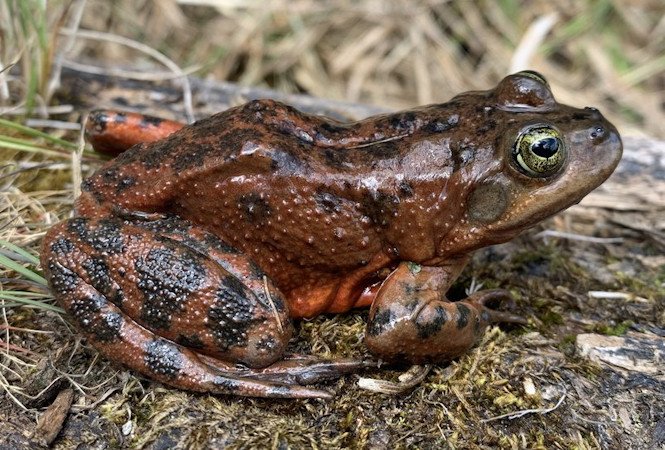Conservation group suing feds over Deschutes River habitat plan, says it’s not enough to protect spotted frog

(Update: Adding video)
Claims plan 'lacks the teeth it needs' ... Deschutes 'treated like an irrigation canal for too long'
BEND, Ore. (KTVZ) — The Center for Biological Diversity filed a formal notice Thursday of its intent to sue two federal agencies for approving a habitat conservation plan in the upper Deschutes River that it claims fails to ensure the Wickiup Dam won’t drive the threatened Oregon spotted frog extinct.
The U.S. Fish and Wildlife Service and Bureau of Reclamation received Thursday’s legal warning.
“I know a lot of work was put into the habitat conservation plan, but it still lacks the teeth it needs to truly protect the Oregon spotted frog,” said Noah Greenwald, endangered species director at the Center. “The upper Deschutes River has been treated like an irrigation canal for too long, and both the river’s health and the frog have suffered.”
Historically, the Deschutes River had relatively stable flows and ample vegetation that stabilized its banks. Since construction of the Wickiup and Crane Prairie dams, the hydrograph on the Deschutes River has essentially been turned upside down, the group says. Late-summer flows are kept extremely high to deliver water for irrigation, and winter flows are dropped very low as water is stored in reservoirs.
Unnaturally high flows in the summer have stripped the upper Deschutes of streamside vegetation, which harms the frog and many other species like beavers and migratory songbirds, the group claims. The low winter flows cause drying of off-channel wetlands, forcing the highly aquatic frog into the main channel where it is exposed to predation from brown trout and many other animals.
“The Deschutes River is one of Oregon’s most treasured rivers and one of the most important for the Oregon spotted frog,” said Meg Townsend, freshwater attorney at the Center. “The Service has failed the frog and the river by perpetuating the same conditions that have pushed the frog closer to extinction, widened the river channel and ravaged vital wetlands.”
The habitat conservation plan was developed by many parties, including irrigation districts and federal agencies. It seeks to help the Deschutes by piping existing canals to reduce water loss and increase the amount of water available to raise flows during the winter. However, this piping is not required by the plan and would not be completed for up to 10 years.
It’s uncertain whether this would even provide enough water to save the frog. The Service determined that the frog needs at least 500 to 600 cubic feet per second of water flow, but the plan only calls for 300 in 10 years, and only 400 in 15 years.
The Service has also said that restoration is needed to ensure that higher winter flows and reduced summer flows don’t harm the frog by preventing water from reaching wetlands in late summer. But the agency has not specified what restoration is needed, who will carry it out or how it will be paid for.
“I’m encouraged to see that some piping has been started, thanks to federal dollars,” said Townsend. “But the Oregon spotted frog might not be able to hold on for a decade while this plan is implemented. Even if it does, there’s a real chance that this plan won’t provide enough water to save the species. This plan avoids real solutions that would help the frog and provide assurances to farmers down the road.”
Both the Service and Bureau have stated they will require increased winter flows, regardless of whether the piping provides sufficient additional water, the group says. However, this would mean the North Unit Irrigation District, which is a junior water rights holder and depends on water released from Wickiup, could lose out on water. In a sadly ironic twist, this water district has arguably done the most to conserve water, the group says.
Townsend told NewsChannel 21 on Friday, “Not only does this not work for the frog, but it doesn't work for the river."
"I mean, it really won't work for the farmers in Central Oregon, either," she claimed, "because the Fish and Wildlife Service says that flows have to come up in the winter and down in the summer, no matter how much effort they put into conservation or water management on their own properties."
A representative of USFWS in Portland said they have no comment on pending litigation.
Craig Horrell, managing director of the Central Oregon Irrigation District, also is president of the Deschutes Basin Board of Control, comprised of eight irrigation districts in Central Oregon "that are critical to conveying water supplies throughout the Deschutes Basin to over 7,600 farm and ranch families, schools, and local parks and recreation districts."
Horrell had this statement Friday on the planned lawsuit:
"As we understand it, the Notice of Intent to sue under the Endangered Species Act sent by the Center for Biological Diversity to the U.S. Fish and Wildlife Service and the U.S. Bureau of Reclamation yesterday (Jan. 12, 2023) does not include the irrigation districts as potential defendants in any lawsuit that Center for Biological Diversity may choose to file as a result of the notice.
"The districts remain fully committed to following the terms and conditions of the incidental take permit issued by the U.S. Fish and Wildlife Service under section 10(a)(1)(B) of the Endangered Species Act.
We strongly believe that our communities should continue to work together from within, rather than take direction from the outside, and remain firmly committed to implementing the conservation measures outlined in the Deschutes Basin Habitat Conservation Plan."